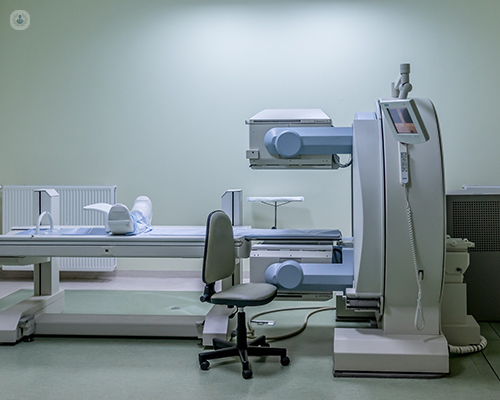An expert's guide to pelvic cancer
Autore:Mr Ashwin Sridhar is a leading consultant urologist and robotic prostate and bladder cancer surgeon based in London. In his latest online article, Mr Sridhar explains in detail the different types of pelvic cancer, the risk factors associated with pelvic cancer as well the treatments available.

What are the types of pelvic cancer commonly encountered by urologists?
The commonly encountered pelvic cancers, include:
- Prostate cancer: Prostate cancer is the most common cancer in men. It starts in the prostate gland, which is a walnut-sized gland that sits below the bladder and in front of the back passage.
- Bladder cancer: Bladder cancer is the second most common cancer in men and the fourth most common cancer in women. It starts in the bladder, which is a muscular sac that stores urine.
What are the primary risk factors associated with pelvic cancer development, and are there any preventive measures?
The primary risk factors associated with pelvic cancer development vary depending on the type of cancer. However, some common risk factors include:
- Age: The risk of developing pelvic cancer increases with age.
- Family history: People with a family history of pelvic cancer are at an increased risk of developing the disease.
- Certain medical conditions: People with certain medical conditions, such as chronic kidney disease, are at an increased risk of developing pelvic cancer.
- Certain lifestyle factors: People who smoke, drink alcohol, or are overweight or obese are at an increased risk of developing pelvic cancer.
There are several preventive measures that can be taken to reduce the risk of developing pelvic cancer. These include:
- Get regular checkups: Regular checkups with your doctor can help to detect pelvic cancer early, when it is most treatable.
- Avoid smoking: Smoking is a major risk factor for many types of cancer, including pelvic cancer. Quitting smoking can help to reduce your risk of developing pelvic cancer.
- Limit alcohol consumption: Excessive alcohol consumption is a risk factor for some types of pelvic cancer. Limiting alcohol consumption can help to reduce your risk of developing pelvic cancer.
- Maintain a healthy weight: Obesity is a risk factor for some types of pelvic cancer. Maintaining a healthy weight can help to reduce your risk of developing pelvic cancer.
- Eat a healthy diet: A healthy diet that is low in processed foods and high in fruits, vegetables, and whole grains can help to reduce your risk of developing pelvic cancer.
- Get regular exercise: Regular exercise can help to the body with recovery for treatment of many types of cancer, including pelvic cancer.

If you are concerned about your risk of developing pelvic cancer, talk to your doctor. Your doctor can help you to assess your risk and recommend preventive measures.
What are the symptoms, diagnostic methods, and staging procedures used to identify urological pelvic cancer?
The symptoms of urological pelvic cancer vary depending on the type of cancer and the stage of the disease. Some common symptoms of pelvic cancer include:
- Blood in the urine
- Pain in the pelvic area
- A lump in the groin
- Changes in urination, such as frequency, urgency, or difficulty urinating
- Painful or bloody ejaculation
- Painful intercourse
- Unexplained weight loss
- Fatigue
The diagnostic methods used to identify pelvic cancer vary depending on the type of cancer and the stage of the disease. Some common diagnostic methods used to identify pelvic cancer include:
- Physical exam: The doctor will perform a physical exam of the pelvic area.
- Blood tests: Blood tests can be used to check for cancer markers, such as prostate-specific antigen (PSA) in men and cancer antigen 125 (CA-125) in women.
- Imaging tests: Imaging tests, such as Ultrasound, computed tomography (CT) scans, magnetic resonance imaging (MRI), and positron emission tomography (PET) scans, can be used to look for tumours and to determine the size and location of the cancer.
- Biopsy: A biopsy is a procedure in which a sample of tissue is taken from the tumour and examined under a microscope to confirm the diagnosis of cancer.
Once a diagnosis of pelvic cancer has been made, the doctor will need to determine the stage of the cancer. The stage of the cancer is determined by the size of the tumour, whether the cancer has spread to other parts of the body, and the extent of the spread. The stage of the cancer is important for determining the best treatment options.

The staging procedures used to determine the stage of pelvic cancer vary depending on the type of cancer. Some common staging procedures used to determine the stage of pelvic cancer include:
- CT scan: A CT scan is a type of X-ray that can be used to look for tumours and to determine the size and location of the cancer.
- MRI: An MRI is a type of scan that uses a strong magnetic field and radio waves to create detailed images of the body. MRI can be used to look for tumours and to determine the size and location of the cancer.
- PET scan: A PET scan is a type of scan that uses a radioactive tracer to look for tumours. PET scans can be used to determine the size and location of the cancer and to see if the cancer has spread to other parts of the body.
Once the stage of the cancer has been determined, the doctor will recommend a treatment plan.
What are the available treatment options for pelvic cancer?
The treatment plan will vary depending on the type of cancer, the stage of the cancer, and the patient's overall health. Some common treatment options for pelvic cancer include:
- Surgery: Surgery is a common treatment option for pelvic cancer. Surgery can be used to remove the tumour, to relieve pain, and to improve the patient's quality of life.
- Radiation therapy: Radiation therapy uses high-energy rays to kill cancer cells. Radiation therapy can be used to shrink tumours before surgery, to kill cancer cells that remain after surgery, or to relieve pain.
- Chemotherapy: Chemotherapy uses drugs to kill cancer cells. Chemotherapy can be used to shrink tumours before surgery, to kill cancer cells that remain after surgery, or to relieve pain.
- Targeted therapy: Targeted therapy uses drugs that target specific molecules on cancer cells. Targeted therapy can be used to shrink tumours or to slow the growth of cancer cells.
- Hormonal therapy: Hormonal therapy uses drugs to block the hormones that cancer cells need to grow. Hormonal therapy can be used to shrink tumours or to slow the growth of cancer cells.
The treatment for pelvic cancer is often a combination of surgery, radiation therapy, chemotherapy, targeted therapy, and hormonal therapy. The goal of treatment is to cure the cancer, to relieve symptoms, and to improve the patient's quality of life.
How do urologists collaborate with oncologists and radiologists to ensure comprehensive care for patients with pelvic cancer in the UK?
Urologists, oncologists, and radiologists collaborate to ensure comprehensive care for patients with pelvic cancer in the UK in a number of ways.
- Multidisciplinary team meetings: Urologists, oncologists, and radiologists meet regularly to discuss patients with pelvic cancer. This allows them to share information about the patient's condition and to develop a treatment plan that is tailored to the patient's individual needs.
- Referrals: Urologists, oncologists, and radiologists refer patients to each other as needed. For example, a urologist may refer a patient to an oncologist for chemotherapy or to a radiologist for radiation therapy.
- Consultations: Urologists, oncologists, and radiologists consult with each other on a regular basis. This allows them to discuss the patient's progress and to make changes to the treatment plan as needed.
- Research: Urologists, oncologists, and radiologists collaborate on research to improve the treatment of pelvic cancer. This research can lead to new treatments and to better ways to manage the side effects of treatment.
The collaboration between urologists, oncologists, and radiologists is essential to ensuring comprehensive care for patients with pelvic cancer. By working together, these specialists can provide patients with the best possible treatment and support.
In addition to the above, urologists, oncologists, and radiologists may also collaborate with other healthcare professionals, such as nurses, social workers, and dietitians, to provide comprehensive care for patients with pelvic cancer. This collaboration can help to ensure that patients have access to the resources they need to manage their cancer and to live well with their diagnosis.
Mr Ashwin Sridhar is a renowned consultant urologist and robotic prostate and bladder cancer surgeon based in London. If you would like to book a consultation with Mr Sridhar you can do so today via his Top Doctors profile.



